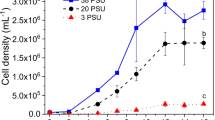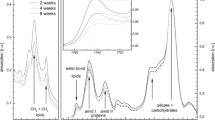Abstract
An ability of marine macroalgae Ulva lactuca (L.) to adapt membrane lipid matrix to elevated seawater temperature depending on rate of warm acclimation was studied. Plants were collected in the Peter the Great Gulf of the Sea of Japan in winter at 4°С and acclimated to summer temperature (20°С) at different rates: 16 or 2°С/day. The fatty acid composition and the crystal – liquid crystal thermal transition of glycolipids (monogalactosyl diacylglycerol, digalactosyl diacylglycerol, sulfoquinovosyl diacylglycerol) and betaine lipid 1,2-diacylglycero-O-4'-(N,N,N-tri-methyl)-homoserine (DGTS) from U. lactuca were investigated by GLC, HPLC-MS and differential scanning calorimetry, respectively. The dependence of the results of temperature acclimation on its rate was shown. Thus, rapid warm acclimation induced the decrease of the ratios of n-3/n-6 polyunsaturated fatty acids and unsaturated/saturated fatty acids, as well as the unsaturation index of fatty acid composition of lipids, which corresponded to seasonal changes. However, this trend did not retain, or even reverse changes occurred at lower warming rate. Redistribution of the composition of molecular forms of glycolipids in acclimated algae led not only to maintain the peak maximum temperature of thermal transition (Tmax), but also to phase separation of glycolipids. This contributed to the fit of the thermogram profiles to those of summer samples. The calorimetric transition of DGTS was most effectively changed: even with rapid acclimation, the Tmax value of the summer sample was reached. In general, U. lactuca showed the ability to adapt lipid matrix of membranes at different rates of warming seawater.

Similar content being viewed by others
REFERENCES
Murakami, Y., Tsuyama, M., Kobayashi, Y., Kodama, H., and Iba, K., Trienoic fatty acids and plant tolerance of high temperature, Science, 2000, vol. 287, p. 476.
Ernst, R., Ejsing, C.S., and Antonny, B., Homeoviscous adaptation and the regulation of membrane lipids, J. Mol. Biol., 2016, vol. 428, p. 4776.
Lauritzen, L., Hansen, H.S., Jorgesen, M.H., and M-ichaelsen, K.F., The essentiality of long chains n-3 fatty acids in relation to development and function of the brain and retina, Prog. Lipid Res., 2001, vol. 40, p. 1.
Sanina, N., Goncharova, S., and Kostetsky, E., Seasonal changes of fatty acid composition and thermotropic behavior of polar lipids from marine macrophytes, Phytochemistry, 2008, vol. 69, p. 1517.
Kostetsky, E., Chopenko, N., Barkina, M., Velansky, P., and Sanina, N., Fatty acid composition and thermotropic behavior of glycolipids and other membrane lipids of Ulva lactuca (Chlorophyta) inhabiting different climatic zones, Mar. Drugs, 2018, vol. 16: 494. https://doi.org/10.3390/md16120494
Seneviratne, S.I., Donat, M.G., Mueller, B., and Alexander, L.V., No pause in the increase of hot temperature extremes, Nat. Clim. Change, 2014, vol. 4, p. 161.
Perkins, S.E., Alexander, L.V., and Nairn, J.R., Increasing frequency, intensity and duration of observed global heatwaves and warm spells, Geophys. Res. Lett., 2012, vol. 39: L20714. https://doi.org/10.1029/2012GL053361
Sandblom, E., Gräns, A., Axelsson, M., and Seth, H., Temperature acclimation rate of aerobic scope and feeding metabolism in fishes: implications in a thermally extreme future, Proc. Biol. Sci., 2014, vol. 281: 20141490. https://doi.org/10.1098/rspb.2014.1490
Ivanova, M.B. and Tsurpalo, A.P., Composition and distribution of macrobenthos communities in the littoral of Putyatin Island (Peter the Great Bay, Sea of Japan), Izv. TINRO, 2013, vol. 172, p. 149.
Kusakin, O.G. and Ivanova, M.B., Composition, distribution and quantitative characterization of the macrobenthos of the littoral of the Bering Sea coast of Kamchatka (Karaginsky and Olyutorsky bays), Izv. TINRO, 2002, vol. 130, p. 266.
Kalita, T.L. and Tytlianov, E.A., Effect of temperature and illumination on growth and reproduction of the green alga Ulva fenestrata,Russ. J. Mar. Biol., 2003, vol. 29, p. 316.
Kobayashi, K., Endo, K., and Wada, H., Roles of lipids in photosynthesis, in Lipids in Plant and Algae Development, Nakamura, Y. and Li-Beisson, Y., Eds., Switzerland: Springer Int. Publ., Ser. Subcell. Biochem., 2016, vol. 86, p. 21.
Van Ginneken, V., Gittenberger, A., Rensing, M., de Vries, E., Peeters, E.T.H.M., and Verheij, E., Seaweed competition: Ulva sp. has the potential to produce the betaine lipid diacylglyceryl-O-4'-(N,N,N,-trimethyl) homoserine (DGTS) in order to replace phosphatidylcholine (PC) under phosphate-limiting conditions in the P-limited Dutch Wadden Sea and outcompete an aggressive non-indigenous Gracilaria vermiculophylla red drift algae out of this Unique Unesco World Heritage coastal area, Ocean. Fish. Open Access J., 2017, vol. 2: 555596. https://doi.org/10.19080/OFOAJ.2017.02.555596
Bligh, E.G. and Dyer, W.I., A rapid method of total lipid extraction and purification, Can. J. Biochem. Physiol., 1959, vol. 37, p. 911. https://doi.org/10.1139/o59-099
Vaskovsky, V.E. and Khotimchenko, S.V., HPTLC of polar lipids of algae and other plants, J. High Resolut. Chromatogr., 1982, vol. 5, p. 635. https://doi.org/10.1002/jhrc.1240051113
Christie, W.W., Equivalent chain length of methyl ester derivatives of fatty acids on gas chromatography, J. Chromatogr., 1988, vol. 447, p. 305.
Carrol, K.K., Quantitative estimation of peak areas in gas-liquid chromatography, Nature, 1961, vol. 191, p. 377.
Kostetsky, E.Y., Velansky, P.V., and Sanina, N.M., Phase transitions of phospholipids as a criterion for assessing the capacity for thermal adaptation in fish, Russ. J. Mar. Biol., 2013, vol. 39, p. 214.
Sanina, N.M., Goncharova, S.N., and Kostetsky, E.Y., Fatty acid composition of individual polar lipids from marine macrophytes, Phytochemistry, 2004, vol. 65, p. 721.
Seebacher, F., White, C.R., and Franklin, C.E., Physiological plasticity increases resilience of ectothermic animals to climate change, Nat. Clim. Change, 2015, vol. 5, p. 61.
Kostetsky, E.Y., Sanina, N.M., and Naumenko, N.V., The influence of fatty acid composition on the profile of the phase transition thermogram of phosphatidylcholine from holothurians Cucumaria fraudatrix,Zh. Evol. Biochem. Physiol., 1992, vol. 28, p. 426.
Kirchhoff, H., Sharpe, R.M., Herbstova, M., Yarbrough, R., and Edwards, G.E., Differential mobility of pigment–protein complexes in granal and agranal thylakoid membranes of C3 and C4 plants, Plant Physiol., 2013, vol. 161, p. 497. https://doi.org/10.1104/pp.112.207548
Brown, M.F., Curvature forces in membrane lipid–protein interactions, Biochemistry, 2012, vol. 51, p. 9782.
Garab, G., Ughy, B., and Goss, R., Role of MGDG and non-bilayer lipid phases in the structure and dynamics of chloroplast thylakoid membranes, in Lipids in Plant and Algae Development, Nakamura, Y. and Li‑Beisson, Y., Eds., Switzerland: Springer Int. Publ., 2016, p. 127.
Yamamoto, Y., Quality control of photosystem II: the mechanisms for avoidance and tolerance of light and heat stresses are closely linked to membrane fluidity of the thylakoids, Front. Plant Sci., 2016, vol. 7: 1136. https://doi.org/10.3389/fpls.2016.01136
Kim, J.H., Kang, E.J., Park, M.G., Lee, B.G., and Kim, K.Y., Effects of temperature and irradiance on photosynthesis and growth of a green-tide-forming species (Ulva linza) in the Yellow Sea, J. Appl. Phycol., 2011, vol. 23, p. 421.
Seiwert, D., Witt, H., Janshoff, A., and Paulsen, H., The non-bilayer lipid MGDG stabilizes the major light-harvesting complex (LHCII) against unfolding, Sci. Rep., 2017, vol. 7: 5158. https://doi.org/10.1038/s41598-017-05328-7
Goncharova, S.N., Kostetsky, E.Ya., and Sanina, N.M., The effect of seasonal shifts in temperature on the lipid composition of marine macrophytes, Russ. J. Plant Physiol., 2004, vol. 51, p. 169.
Wallis, J.G. and Browse, J., Lipid biochemists salute the genome, Plant J., 2010, vol. 61, p. 1092.
Savchenko, T.V., Zastrijnaja, O.M., and Klimov, V.V., Oxylipins and plant abiotic stress resistance, Biochemistry (Moscow), 2014, vol. 79, p. 362.
Funding
The work was funded by the Ministry of Science and Higher Education of the Russian Federation as part of the state assignment number 6.5736.2017/6.7.
Author information
Authors and Affiliations
Corresponding author
Ethics declarations
The authors declare no conflict of interest. This article does not contain any research with the participation of people and animals as objects of research.
Additional information
Abbreviations: DGDG— digalactosyldiacylglycerol; DGTS—1,2-diacylglycero-O-4'-(N,N,N-tri-methyl)-homoserine; DSC—differential scanning calorimetry; UI—unsaturation index; MGDG—monogalactosyldiacylglycerol; SFA—saturated fatty acids; PUFA—polyunsaturated fatty acids; SQDG—sulfoquinovosyldiacylglycerol; Tmax—the peak maximum temperature of thermal transition; PC—phosphatidylcholine; PE—phosphatidylethanolamine.
Rights and permissions
About this article
Cite this article
Barkina, M.Y., Pomazenkova, L.A., Chopenko, N.S. et al. Influence of Warm-Acclimation Rate on Polar Lipids of Ulva lactuca. Russ J Plant Physiol 67, 111–121 (2020). https://doi.org/10.1134/S1021443720010021
Received:
Revised:
Accepted:
Published:
Issue Date:
DOI: https://doi.org/10.1134/S1021443720010021




